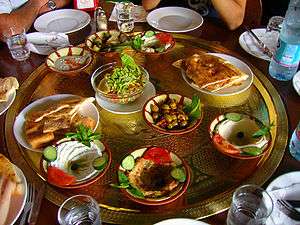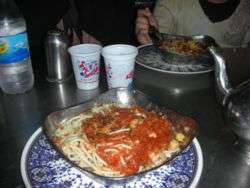Arab cuisine
Arab cuisine (Arabic: مطبخ عربي) is defined as the various regional cuisines spanning the Arab world, from the Maghreb to the Mashriq or Levant and the Persian Gulf. The cuisines are often centuries old and resemble and culture of great trading in spices, herbs, and foods. The three main regions, also known as the Maghreb, the Mashriq, and the Khaleej have many similarities, but also many unique traditions. These kitchens have been influenced by the climate, cultivating possibilities, as well as trading possibilities. The kitchens of the Maghreb and Levant are relatively young kitchens which were developed over the past centuries. The kitchen from the Khaleej region is a very old kitchen. The kitchens can be divided into the urban and rural kitchens.
Diet and foods
The Arabian cuisine uses specific and sometimes unique foods and spices. Some of those foods are:
- Meat: lamb and chicken are the most used, with beef, goat. Other poultry is used in some regions, and fish is used in coastal areas like the Mediterranean sea, Atlantic ocean or the Red sea. Pork is completely prohibited for Muslim Arabs, being both a cultural and religious taboo (Haram) and prohibited under Islamic law, whereas many Christian Arabs do eat and enjoy pork products, especially in Lebanon, where cold cuts of ham are frequently consumed in Christian neighbourhoods.[1]
- Dairy products: dairy products are widely used, especially yogurt, Buttermilk and white cheese. Butter and cream are also used extensively.
- Herbs and spices: The amounts and types used generally varies from region to region. Some of the included herbs and spices are sesame, saffron, Black pepper, Allspice, turmeric, garlic, cumin, cinnamon, Parsley, Coriander and sumac. Spice mixtures include baharat, Ras el hanout, Za'atar, Harissa.
- Beverages: hot beverages are served more than cold, coffee being on the top of the list in the Middle-eastern countries and tea on top of the Maghreb countries. In Jordan, Some part of Syria, Morocco and Algeria tea is much more important as a beverage. Other Arabian drinks include Andalucian Horchata and Maghrebi avocado smoothie.
- Grains: rice is the staple and is used for most dishes; wheat is the main source for bread. Bulgur and semolina are also used extensively.
- Legumes: lentils are widely used in all colours, as well as fava beans, chickpeas (garbanzo beans),scarlet runner beans, green peas, lupini beans, white beans and brown beans.
- vegetables: Arabian cuisine favors vegetables such as carrots, eggplant (aubergine), zucchini (courgette), artichokes, okra, onions and Olives. Potatoes are also eaten as vegetables in Arabian culture.
- Fruits: Arabian cuisine favors fruits such as Pomegranate, Dates, Figs, oranges, citruses, watermelons, Cantaloupe, Honeydew melon, grapes, peaches and nectarines.
- Nuts: almonds, peanuts, pine nuts, pistachios, and walnuts are often included in dishes or eaten as snacks.
- Greens: parsley, Coriander and mint are popular as seasonings in many dishes, while spinach and mulukhiyah (leaves from the plant of the Corchorus genus) are used in cooked dishes.
- Dressings and sauces: the most popular dressings include various combinations of olive oil, lemon juice, parsley or garlic, as well as tahini (sesame paste). Labaneh (thinned yogurt) is often seasoned with mint, onion, or garlic, and served as a sauce with various dishes.
Bedouin kitchen
The Bedouins of the Arabian Peninsula, Middle-East and North-Africa relied on a diet of dates, dried fruit, Nuts, wheat, barley, rice, and meat. The meat existed out of big animals like cows, sheep and lambs. Dairy like milk, cheese, yoghurt, buttermilk (Labneh). The bedouins would also use many different dried beans like white beans, lentils and chickpeas. Vegetables which were used a lot among the bedouins are variants which could be dried like pumpkins. But also vegetables which are more heat-resistant like aubergines. They would drink a lot of fresh Verbena tea, Arabian tea, Maghrebi mint tea or Arabic coffee. A daily break to freshen up with drinks is a much loved tradition. The bread which is eaten a lot is called Khobz as well in the Khaleej as in the Maghreb regions. Dishes like Marqa, Stews, Tajines were prepared traditionally among the bedouins. Breakfast existed of baked beans, bread, nuts, dried fruits, milk, yoghurt and cheese and tea or coffee. Snacks included nuts and dried fruits.
Culture
Essential to any cooking in the Arab world is the concept of hospitality and generosity. Meals are generally large family affairs, with much sharing and a great deal of warmth over the dinner table. Formal dinners and celebrations generally involve large quantities of lamb, and every occasion entails large quantities of Arabic coffee or Arabic tea.
Khaleej
Coffee ceremony: In the Khaleej region, a visitor awaits a great table of dried fruits, fresh fruits, nuts and cakes with syrup. Dried fruits include figs, dates, apricots and plums. Fresh fruits include citruses, melons and pomegranate. Arabic Coffee is served the most, but Arabic tea is also a great refresher. Spices are often added in the coffee or other drinks.
Dinner guests: In the khaleej region, a visitor might expect a dinner consisting of a very large platter, shared commonly, with a vast amount of spiced rice, incorporating cooked spicy lamb or chicken, or both, as separate dishes, with various stewed vegetables, heavily spiced, sometimes with a tomato-based sauce. Different types of bread are served with different toppings specific to the region. Tea would certainly accompany the meal, as it is almost constantly consumed. Coffee would be included in the same manner.
Maghreb
Tea/coffee ceremony: In the Maghrebi region, a visitor might expect a table full of bread-like snacks which include Msemen, Baghrir and other stuffed breads. These are served with honey, rosewater or olive oil. There are also many different cookies and cakes included accompanied by plates with different kinds of nuts. Arabic coffee and Mint tea is often served with it in a traditional Maghrebian teapot.
Dinner guests: In the Maghrebi region, a visitor might expect a table with different kinds of stews, also called Marqa's or Tajine's. Dishes like Couscous or other semolina based dishes are much appreciated as well. These main dishes are accompanied by smaller mezze like plates with salads, sauces and dips. Breads like Msemen and Khobz are used to eat the stews with.
Levant
Coffee/ Tea ceremony: In an average Arabian Levantian household, a visitor might expect a table full of Mezze's, breads topped with spices like Za'atar and nuts. In the levant region, Arabian coffee is a much loved beverage, but Arabian tea is also much loved in Jordan and Palestine.
Dinner guests: In the Levantian region, a visitor might expect a table with different kinds of mezzes, nuts, dips and oils. Mezzes include Hummus, Baba ghanoush, Falafel, Kibbeh, Kafta, smoked vegetables and Tabouli salads. The nuts can differ from almonds to walnuts, with different spice coatings. The dips and oils include hummus and olive oil.
There are many regional differences in the Arabian cuisine. For instance, mujadara in Syria and Lebanon is different from mujadara in Jordan and Palestine. Some dishes, such as mansaf (the national dish of Jordan), are native to certain countries and rarely, if ever, make an appearance in other countries. Unlike in most Western cuisines, cinnamon is used in meat dishes, as well as in sweets such as baklava. Dishes like Tajine and Couscous can differ from Morocco to Libya, with their unique preparations. Other dishes like the arabo-andalucian Bastilla or Albondigas have different traditional spicemixes and fillings in the Maghreb region.
Structure of meals
There are two basic structures for meals in the Arab World, one regular and one specific for the month of Ramadan.
Breakfast
Cafés often serve croissants for breakfast. Breakfast is often a quick meal, consisting of bread and dairy products, with tea and sometimes jam. The most used is labneh and cream (kishta, made of cow's milk; or qaimar, made of domestic buffalo milk). Labneh is served with olives, dried mint, and drizzled with olive oil. Pastries such as manaqeesh, sfiha, fatayer, and kahi are sometimes eaten for breakfast. Flat bread with olive oil and za'atar is also popular. Most Arab families also consume hummus and falafel with pita bread.
Traditionally, breakfast used to be a much heavier meal, especially for the working class, and included dishes such as lentil soup (shorbat 'adas), or heavy sweets such as knafa. Ful, which is fava beans cooked with chickpeas (garbanzo beans), garlic, lemon, and olive oil, is a popular working class breakfast in the Levant and Egypt. Lablabi is another heavy garbanzo-based stew popular for breakfast in Tunisia.
Lunch
Lunch is considered the main meal of the day, and is traditionally eaten between 1:30pm and 2:30pm. It is the meal for which the family comes together, and when entertaining, it is the meal of choice to invite guests to. Rarely do meals have different courses; however, salads and mezze (an appetizer) are served as side dishes to the main meal. The platter usually consists of a portion of meat, poultry or fish, a portion of rice, lentils, bread or bagel, and a portion of cooked vegetables, in addition to the fresh ones with the mezze and salad. The vegetables and meat are usually cooked together in a sauce (often tomato, although others are also popular) to make maraq, which is served on rice. Most households add bread, whether other grains were available or not. Drinks are not necessarily served with the food; however, there is a very wide variety of drinks such as shineena (or laban), karakaden, Naqe'e Al Zabib, irq soos, tamr Hindi, and fruit juice, as well as other traditional Arab drinks. During the 20th century, carbonated soda and fruit-based drinks, sold by supermarkets, have also become very popular.
Dinner
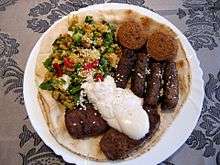
Dinner is traditionally the lightest meal, although in modern times, and due to changing lifestyles, dinner has become more important.
Desserts and Ramadan meals
In addition to the two meals mentioned hereafter, sweets are consumed much more than usual during the month of Ramadan; sweets and fresh fruits are served between these two meals. Although most sweets are made all year round such as knafeh, baklava, and basbousa, some are made especially for Ramadan, such as qatayef.
Iftar
Iftar (also called Futuur, or Afur in the Somali language), or fast-breaking, is the meal taken at dusk when the fast is over. The meal consists of three courses: first, they shall eat a date based on Islamic tradition. This is followed by a soup or anything they would like, the most popular being lentil soup, but a wide variety of soups such as chicken, oats, freeka (a soup made from whole wheat and chicken broth), potato, maash, and others are also offered. The third course is the main dish, usually eaten after an interval, when Maghreb prayer is conducted. The main dish is mostly similar to lunch, except that cold drinks are also served.
Sahur
Sahur is the meal eaten just before dawn, when fasting must begin. It is eaten to help the person make it through the day with enough energy until Maghreb time.
Regional Arab cuisines
Hejaz
Bukhari rice (روز البخاري) (Ruz al Bukhari) is a dish eaten in the Hejaz, Saudi Arabia. It is a rice with spicy tomato sauce, flavoured chicken and a fresh salad. It is a much eaten dish in the Hejaz district of Saudi-Arabia.
Eastern Arabia
The cuisine of Eastern Arabia today is the result of a combination of diverse cuisines, incorporating Levantine and Yemeni cuisines.[2] Dishes like harees, fattah, and many other dishes are originally from the Persian Gulf.
Yemen
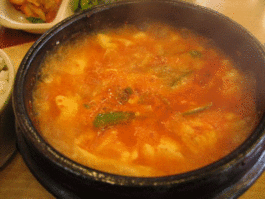
The cuisine of Yemen is rather distinct from other Arab cuisines. Like most other Arab cuisines, chicken, goat, and lamb are eaten more often than beef. Fish is eaten mostly in coastal areas. However, unlike most Arab countries, cheese, butter, and other dairy products are less common, especially in the cities and other urban areas. As with other Arab cuisines, the most widespread beverages are tea and coffee; tea is usually flavored with cardamom, clove, or mint, and coffee with cardamom. Karakaden, Naqe'e Al Zabib, and diba’a are the most widespread cold beverages.
Although each region has their own variation, Saltah (سلتة) is considered the national dish of Yemen. The base is a brown meat is called maraq (مرق), a dollop of fenugreek froth, and sahawiq (سحاوق) or sahowqa (a mixture of chili peppers, tomatoes, garlic, and herbs ground into a salsa. Rice, potatoes, scrambled eggs, and vegetables are common additions to saltah. It is eaten with flat bread, which serves as a utensil to scoop up the food. Other dishes widely known in Yemen include: Aseedah, aseed, fahsa, thareed, Samak Mofa, mandi, fattah, shakshouka, shafut, Bint Al-Sahn, kabsa, and jachnun. Nasi kebuli Harees Hyderabadi haleem. Hadhrami restaurants can be found in Malaysia.[3][4][5]
The Levant and Mashriq: Iraq, Syria, Lebanon, Palestine, Jordan
Levantine cuisine is the traditional cuisine of the Levant, Mashriq, or Greater Syria area. Although now divided into Syria, Lebanon, Jordan, Iraq, and Palestine, the region has historically been more united, and shares most of the same culinary traditions. Although almost identical, there is some regional variation within the Levantine area.
Dishes include olive oil, za'atar, and garlic, and common dishes include a wide array of mezze or bread dips, stuffings, and side dishes such as hummus, falafel, ful, tabouleh, labaneh, and baba ghanoush.
It also includes copious amounts of garlic and olive oil, often seasoned with lemon juice—almost no meal goes by without including these ingredients. Most often foods are either grilled, baked, fried, or sautéed in olive oil; butter and cream are rarely used, other than in a few desserts. Vegetables are often eaten raw or pickled, as well as cooked. While the cuisine does not boast a multitude of sauces, it focuses on herbs, spices, and the freshness of ingredients.
Iraq
Iraq is where the first cookbook was ever recorded in history, historically in Baghdad and Mesopotamia. Iraq is one of the oil-rich Arab countries surrounding the Persian gulf and is also part of the Levant and Mashriq sharing similarities in cooking and cuisines between both the surrounding regions of the Arab world. Iraqi cuisine mainly consists of meat, rather than appetizers. In Iraqi cuisine, the most common meats are chicken and lamb. The national dish of Iraq is the Masgouf fish, usually enjoyed with grilled tomatoes and onions. Iraqi cuisine utilizes more spices than most Arab cuisines. Iraq's main food crops include wheat, barley, rice, vegetables, and dates. Vegetables include eggplant, okra, potatoes, and tomatoes. Pulses such as chickpeas and lentils are also quite common. Common meats in Iraqi cooking are lamb and beef; fish and poultry are also used.
Soups and stews are often prepared and served with rice and vegetables. Biryani, although influenced by Indian cuisine, is milder with a different mixture of spices, and a wider variety of vegetables, including potatoes, pea's, carrot's, and onion's. Dolma is also one of the most popular dishes.
The Iraqi cuisine is famous for its extremely tender kebab, as well as its tikka. A wide variety of spices, pickles, and amba are also extensively used.
Greater Syria
In Filistine and Jordan, the population has a cooking style of their own, involved in roasting various meats, baking flat breads, and cooking thick yogurt-like pastes from goat's milk.
Musakhan is a common main dish, famous in northern Jordan, the city of Jerusalem, and northern West Bank. The main component is taboon bread, which is topped with pieces of cooked sweet onions, sumac, saffron, and allspice. For large dinners, it can be topped by one or two roasted chickens on a single large taboon bread.
The primary cheese of the Palestinian mezze is Ackawi cheese, which is a semi-hard cheese with a mild, salty taste and sparsely filled with roasted sesame seeds.
Maqluba is another popular meal in Jordan and central Palestine. Mujaddara, another food of the West Bank, as well as in the Levant in general, consists of cooked green lentils, with bulghur sauteed in olive oil. Mansaf is a traditional meal, and the national dish of Jordan, having roots in the Bedouin population of the country. It is mostly cooked on special occasions such as Ramadan, Eid ul-Fitr, a birth, or a large dinner gathering. Mansaf is a leg of lamb or large pieces of mutton, on top of a markook bread that has been topped with yellow rice. A type of thick dried yogurt made from goat's milk, called jameed, is poured on top of the lamb and rice to give it its distinct flavor and taste. The dish is garnished with cooked pine nuts and almonds.
Levantine cuisine is also famous for its wide range of cheeses like Shanklish, Halloum, and Arisheh. Kishk is also a famous Syrian soup, alongside many soups made of lentils. Lebanese food also has a wide range of dips like Hummous, Baba Ghannouj, and Labneh, and also caters many raw meat dishes. Syrian food could be either extremely vegetarian or a meat lover's paradise. Lemon, oregano, za'atar, paprika, and various other Mediterranean spices and herbs are used in Syrian cuisine.
To top it off, Levantine cuisine also incorporates wines made in Lebanon, Syria, Jordan and Palestine and the Levantine equivalent of the Greek Ouzo, known as Arak.
Egypt
Egypt has a very rich cuisine with many unique customs. These customs also vary within Egypt itself, for example, in the coastal areas, like the coast of the Mediterranean Sea and Canal, the diet relies heavily on fish. In the more rural areas, reliance on farm products is much heavier. Duck, geese, chicken, and river fish are the main animal protein sources. Unlike the surrounding Arab cuisines, which place heavy emphasis on meat, Egyptian cuisine is rich in vegetarian dishes; three national dishes of Egypt; ful medames, ta‘miya (also known in other countries as falafel), and kushari, are generally vegetarian. Fruits are also greatly appreciated in Egypt: mangoes, grapes, bananas, apples, sycamore, guavas, and peaches are very popular, especially because they are all domestically produced and are available at relatively low prices. The most famous dessert from Egypt is called Om Ali, which is similar to a bread and butter pudding made traditionally with puff pastry, milk, and nuts. It is served all across the Middle East and is also made on special occasions such as Eid.[6] Bread is a staple in Egypt, the most common breads are eish baladi (Egyptian Arabic: عيش البلدي) and eish merahrah (Egyptian Arabic: عيش مرحرح).
Libya
Libyan cuisine is a unique cuisine which is used all over the Maghreb. It includes majorily Arabian and bedouin dishes and also has ancient Libyan dishes. The dishes include many different spices and herbs, and the Libyan kitchen also includes hot spiced like Tunesia.
Dishes

- Bazin – Libyan bread
- Bsisa
- Couscous
- Harissa
- Hassaa
- Lebrak – Filled grapeleaves with rice and minced meat
- Libyan Boureek
- Libyan summer salad
- Marqa or Tajine
- Mbatten
- Mbekbka – a unique Libyan soup with pasta or spaghetti. Instead of the European way of boiling pasta or spaghetti in water and then throwing the water away (with all the goodness it contains), the Libyans boil pasta with the sauce, which adds a real pasta flavour to the sauce. You can make it with any type of pasta, and the simplest dish involves frying onions in oil, throwing in the tomato puree, chili powder, turmeric, then adding water and salt and leave to boil, before adding the pasta. But the proper way to do it is to add some lamb chops, chickpeas and garlic to the sauce. Serve hot with a sprinkle of extra virgin olive oil, lemon, fresh chili and crusty bread (optional). You can also add other vegetable like pumpkin, potato and green pepper
- Shakshouka
- Sherba – Libyan soup
- Shorba Arabia
- Usban
- Zumita
- Asida
Desserts
- Ghreyba
- Maghrood
- Mhalbiya
Morocco
Main dishes
- Bastilla (Arabic: بسطلة): The pancake is a traditional Moroccan tart filled with pigeons or chicken.
- Couscous (Arabic:كسكس): Couscous is a traditional Arabian dish made of small semolina balls and a Marqa (Tajine) on top.
- Harira (Arabic:حريرة): The Harira is a traditional Moroccan tomato soup consumed during the Holy month of Ramadan. It is a thick soup with beans and vegetables in it.
- Tajine (Arabic:طاجين): The Tajine is a traditional Arabian stew made with spices and herbs, meat and vegetables. Other common combinations are tajines combined with sweet dried fruits like dates, dried plums and dried apricots.
- Taktouka (Arabic:تكتكة): The Taktuka is a traditional Moroccan salad made with tomatoes, onions, coriander and smoked green paprika.
- Zaalouk:
Breads and pancakes
- Khobz (Arabic:خبز): The Khobz is a type of bread which is consumed with broths like the Tajine.
- Msemen (Arabic:مسمن): The word Msemen is derived from the Smen which is a clarified butter used a lot amongst Arabs. The Msemen is a type of bread, which is consumed on its own with honey or olive oil.
- Baghrir (Arabic:بغرير): The baghrir is a type of pancake with many holes in it. It is consumed in Morocco and other Maghreb countries.
- Harsha (Arabic:حرشة ): The Harsha is a type of bread made of Semolina. It is consumed in during breakfast or during a high-tea, together with honey or butter.
Moroccan spice mixes
- Chermoula (Arabic:شرمولة): is a marinade which is used to flavor fish or seafood, but it can be used on other meats or vegetables. Chermoula is often made of a mixture of herbs, oil, lemon juice, pickled lemons, garlic, cumin, and salt.[7]
- Ras el Hanout (Arabic:راس الحانوت): Ras el Hanout means "head of the store", and is an Arabian spice mix made with 20 or more spices and herbs.[8]
- Harissa
Sweets and pastries
- Chebakia (Arabic:شبكية): Chebakia is derived from the Arabic word "Chabaka" meaning "baskets" is a traditional pastry eaten during the Holy month of Ramadan.
- Kab el Ghazal (Arabic:قب الغزل ): Kab el Ghazal literally translates from Moroccan Arabic as "gazelle ankles", these crescent-shaped cookies are famously known as Gazelle Horns, or Cornes de Gazelle in French. They're frequently served at special occasions like Eid or visitations. Almond paste scented with orange flower water and cinnamon is enclosed in a delicate pastry, molded into a crescent, and then baked until golden. A dip in orange flower water followed by a dusting of powdered sugar is optional – in that case, the pastries are referred to as Kaab el Ghazal M'fenned.[9][10]
- Briouat (Arabicبريوات ): Briout means "little envelopes" is Arabic, and is a pastry made by wrapping a filling in thin pastry dough and then frying. The fillings might be savory or sweet. In the popular Almond Briouat version, the pastries are filled with fresh almond paste flavored with orange flower water and cinnamon. Once fried, the pastries are then given a short soaking in hot honey for flavor and sweetness. Almond Briouats are commonly served at both special occasions and casual tea times.[11]
Sudan
In comparison to its North African and Levantine neighbors, the cuisine of Sudan tends to be generous with spices. The Sudanese cuisine has a rich variety in ingredients and creativity. Simple everyday vegetables are used to create stews and omelettes that are healthy yet nutritious, and full of energy and flair. These stews are called mullah. One could have a zucchini mullah, spinach "Riglah" mullah, etc. Sudanese food inspired the origins of Egyptian cuisine and Ethiopian cuisine, both of which are very popular in the Western world. Popular dishes include Ful medames, Shahan ful, Hummus, Bamya (a stew made from ground, sun dried okra), and Gurasa (pancake), as well as different types of salads and sweets.
-

Shahan ful presented alongside olive oil, berbere, various vegetables, and a roll of bread
Dishes
| Name | Image | Description |
|---|---|---|
| Basbousa بسبوسة |  |
|
| Dolma ضولمة | ||
| Ful Medames فول مدمس |  |
An Egyptian dish of cooked and mashed fava beans served with vegetable oil, cumin, and optionally with chopped parsley, onion, garlic, lemon juice, and chili pepper. |
| Kleeja كليجا |  |
|
| Maqluba مقلوبه | ||
| Mutabbaq مطبق | A stuffed pancake or pan-fried bread, which is commonly found in Saudi Arabia (especially the Tihamah and the Hejaz regions), Yemen, India, Indonesia, Malaysia, Singapore, Brunei and Thailand. | |
| Pickled lemon ليمون مخلل |  |
|
| Shish kebab كباب | 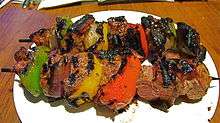 |
|
| Tharida | A soup prepared with broth, stewed meat and bread crumbs |
-

Lahm Ba'ajeen لحم بعجين
-

Manakish مناقيش
-

Kabsa كبسة
-
Kebbeh كبة-كبيبة
-

Matboha مطبوخة
-

Baba Ghanoush بابا غانوج
-
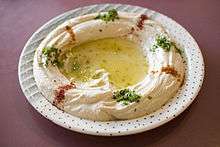
Hummus حمصية
-

Waraq Enab ورق عنب - ملفوف
-
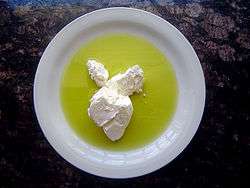
Labneh لبنة
-

Ka'ak كعك - كحك
-
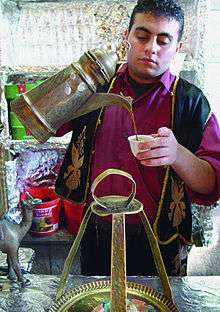
Coffee قهوة
-
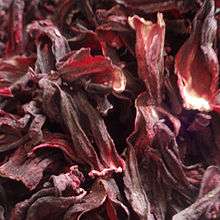
Hibiscus tea كركديه - عنآب
-

Halva حلاوة
-
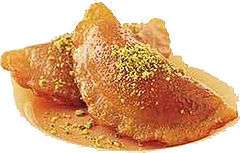
Qatayef القطائف
-
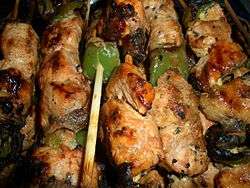
Shish taouk شيش طاوك
-

Toum تومية
-
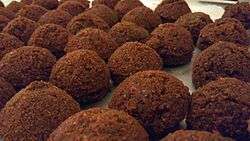
Falafel فلافل - طعمية
-

Kleicha الكليجة - كعب الغزال
See also
References
- ↑ Nabeel Y. Abraham. "Arab Americans," Encarta Encyclopedia 2007. Archived 2009-10-31.
- ↑ "Daily Traditional Gulf Cuisine food recipes by Shahiya.com 1". Shahiya.com. Retrieved 2016-01-07.
- ↑ "Hadhramaut continues to highlight Arabic presence in Malaysia - Culture & Art - 13/12/2013". KUNA.net. 2013-12-13. Retrieved 2016-01-07.
- ↑ "KUNA : Hadhramaut continues to highlight Arabic presence in Malaysia - Culture & Art - 13/12/2013". 158.50.10.7. 2013-12-13. Retrieved 2016-01-07.
- ↑ GRACE CHEN (2012-07-07). "Archives | The Star Online". Thestar.com.my. Retrieved 2016-01-07.
- ↑ "Umm Ali Recipe - Egyptian Bread Pudding".
- ↑ The Art of Moroccan Cuisine | Fes Cooking and Cultural Tours". Fescooking.com. Retrieved 2013-11-06.
- ↑ Authentic Recipes from Morocco. Written byFatema Hal. 13-07-2016
- ↑ http://moroccanfood.about.com/od/dessertsandcookies/r/kaab_el_ghazal_gazelle_horns.htm
- ↑ http://cookingwithalia.com/gazelle-horns-covered-with-sesame-seeds/
- ↑ http://moroccanfood.about.com/od/tipsandtechniques/ss/How-To-Make-Almond-Briouats-Moroccan-Almond-Pastries-With-Honey.htm
External links
-
 Media related to Arabic cuisine at Wikimedia Commons
Media related to Arabic cuisine at Wikimedia Commons
